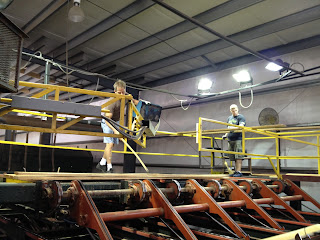On Thursday, September 6th, our group got back together to visit a few more places that we couldn't squeeze into the summer tour. The first stop was Weyerhaeuser Company Sutton OSB. Located in Sutton, WV, Weyerhaeuser produces oriented strand board (also known as OSB). OSB is generally used in the same methods as plywood. OSB is great for the environment since scrap wood and tree tops, formally discarded or wasted, can be used to form a useful product.
Step 1: Logs are chipped using this 84" diameter chipper that is made up of 46 knives. These chips are referred to as "green strands." Strands can be up to six inches long.
Step 2: The green strands are then moved to a dryer. Moisture is removed until the infrared meters show the moisture content to be down to 5 - 8%. The time it takes for this to occur varies depending on the species of the wood, the amount of time the logs were able to dry in the lumberyard before being processed, etc...
Step 3: The dried strands are then moved to the blender where they are mixed with wax and resin.
Step 4: The resinated strands are oriented to form mats. The top and bottom layers of the finished product have vertical strands, while the two middle layers are horizontal. This provides the OSB with more strength.
 |
| Nearly the whole operation is monitored and controlled by these two people. |
Step 5: Four layers of the oriented board are then stacked and pressed for 4 - 6 minutes. The stacks which are 6 - 8 inches tall before the press come out to specified thicknesses (usually around 5/16").
Step 6: Each large mat is then trimmed and cut to form 108 4x8 panels.
This plant produces approximately 60 truck loads of OSB each day and 24 rail car loads each week. The entire process from green logs to a finished product takes about 3 hours.
The next visit of the day was Appalachian Timber Services. They provide a variety of products from railroad ties to bridge and coal mining supports.
 |
| The largest customer of ATS is the New York City rail system. |
THINK: How many board feet are in one railroad tie? If the tie is 10 feet long, what could the width and height be? (You may need to refer to the blog post about estimating board feet from May 5, 2012.)
 |
| Workers often have to hand carve the forms for bridge repairs since every bridge is built to different specifications. |
 |
| This is an new design for coal mine roof posts. It helps prevent the posts from collapsing during a cave-in. |






















































